Antique Desire
AUCTION FINDS OF THE WEEK- JUNE 17TH: 20TH CENTURY DESIGN PART III
by Kelly Keating on 06/21/13
This week is the third installment of auction finds all designed in the 20th century. All lots are being auctioned at Skinner in Boston on June 22nd and feature Arts & Crafts, Art Deco and Mid-century Modern objects. Hopefully, one of these lots will inspire the decoration of your own living space whether in terms of shape, sentiment or color.
The first discovery this week, lot 438, is a piece of mid-century electronics, an early Philco Predicta Television with a pre-sale estimate of $400-600. The TV is made of metal, glass and fabric, has a swivel screen and dates to the 1940's. TV was commercially available since the 1920's, but it achieved true dominance in the 1950's. This early TV at Skinner would make an interesting objet d'art on a sideboard or in a large bookshelf as an artifact of the medium or a piece from a future alien archaelogical dig.
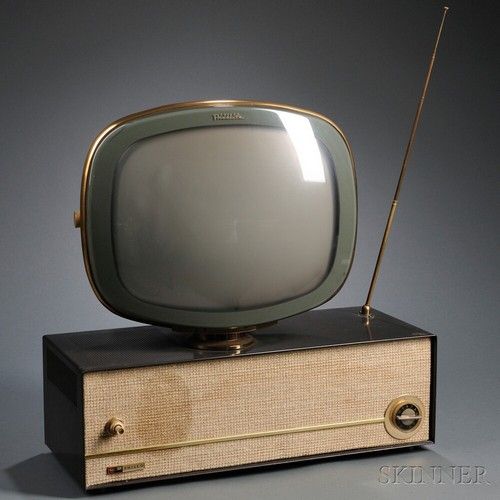
This week's next treasure is an Arts & Crafts screen, lot 189, with a pre-sale estimate of $500-700. The screen is composed of four hinged sections, each decorated with a brocade peacock feather patterned fabric in gold, blue, and brown above a panel carved with scrolling leaf and foliate designs. It dates to the early 20th century and is made of oak. Using a screen in a room is a wonderful way to frame a corner, hide a door or as a backdrop to a sofa. The peacock fabric of this piece is particularly fab and could be the starting point for an entire room design.
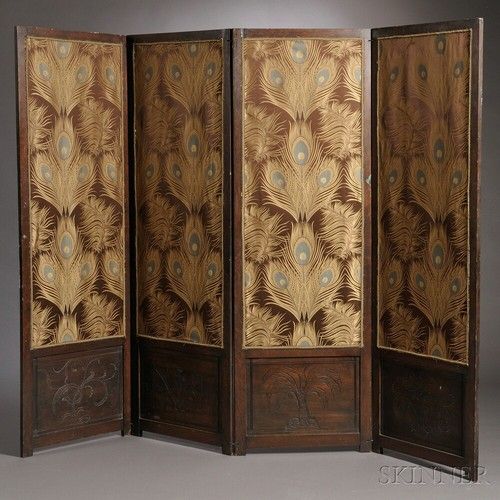
The third treasure this week is the first of two Art Deco lots. Lot 462 is a Russel Wright (1904-1976) spun aluminum spherical lidded bowl, ladle, removable "ring" tray and twelve cups with wooden ball accents with a pre-sale estimate of $1,000-1,500. All bowl and cups all impressed on the base: Russel Wright. The piece is dated to circa 1935.This piece makes me think of Flash Gordon and the serials of the 1930's and later 1950's science fiction films. Its Art Deco identity is hallmarked by its streamlined design, futuristic space references and the use of its materials. What a wonderful display piece on your modern sideboard and how fun would it be to use this punch bowl at a party.
Russel Wright was an American Industrial designer during the 20th century. Beginning in the late 1920s through the 1960s, he created a succession of artistically distinctive and commercially successful items that helped bring modern design to the general public. Russel Wright’s method of design came from the belief that the table was the center of the home. Designing in layers from there outwards, he designed tableware to larger furniture, architecture to landscaping, all according to his concept of easy, informal living. It was through his immensely popular and widely distributed housewares and furnishings that he revolutionized the way Americans lived and organized their homes in the mid 20th century.
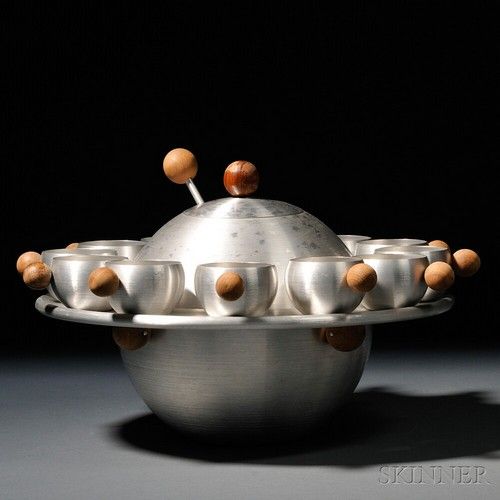
The second Art Deco lot this week is a pair of French upholstered lounge chairs circa 1925, lot 400, with a pre-sale estimate of $1,500-2,500. The chairs have a straight seat back over flat wood arms angled at front and continuing down to the base which is raised on four stepped feet. Stylish and comfortable this pair of chairs could fit into almost any setting and would be heightened by a rich and luxurious fabric from modern to traditional.
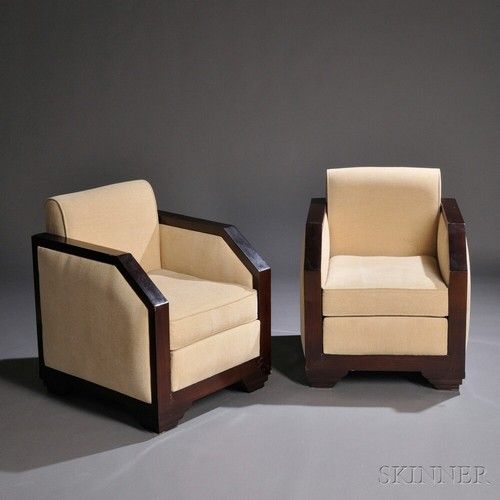
The final two discoveries this week are both chairs and both Mid-century Modern pieces, one Danish and one American. Lot 474 is a Hans Wegner (1914-2007) Danish "Mama Bear" Chair on four tapered cylindrical legs. It is made of teak, walnut and upholstery and dated circa 1950's with a pre-sale estimate of $4,000-6,000. This piece is Wegner's take on the traditional wingchair. Everything is simplified and paired down, but the chair still exudes a cozy feel.
Wegner was a world renowned Danish furniture designer. His high quality and thoughtful work, along with a concerted effort from several of his manufacturers, contributed to the international popularity of mid-century Danish design. His style is often described as Organic Functionality, a modernist school with emphasis on functionality. This school of thought arose primarily in Scandinavian countries with contributions by Poul Henningsen, Alvar Aalto, and Arne Jacobsen. In his lifetime he designed over 500 different chairs, over 100 of which were put into mass production and many of which have become recognizable design icons.
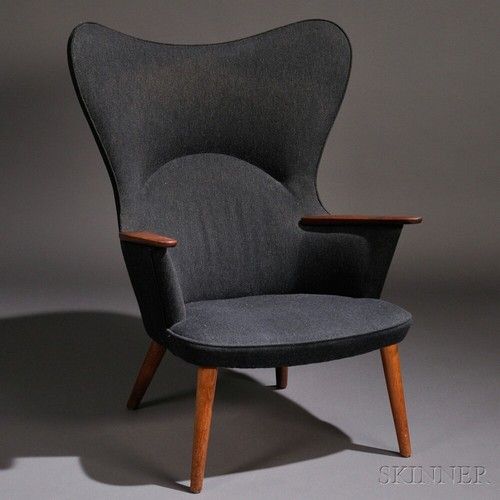
The second Mid-century Modern chair is lot 705, a Cherner Plycraft armchair from Lawrence, MA and dated circa 1958 with a pre-sale estimate of $250-350. The piece is constructed of laminated plywood with a shaped back to seat with curvilinear arms. This armchair has a wonderfully dynamic and organic feel. It could be a functional piece of sculpture in a very smart interior or how about a set of 4, 6, or 8 for a dining room.
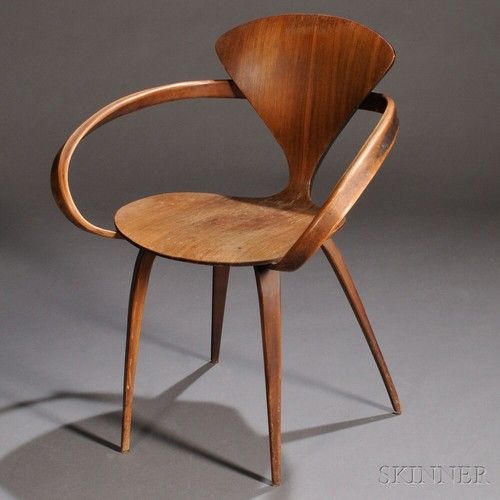
This week was the third installment of auction finds that express the best in 20th century modern design. I hope one of these pieces gave you a new thought or idea for the design and decoration of your own interior space whether it is Arts & Crafts, Art Deco or Danish or American modernism.
If you are looking for a particular object and would like my help, please contact me at [email protected].
Till next week,
Kelly T Keating
www.theantiqueflaneur.com
AUCTION FINDS OF THE WEEK- JUNE 10TH: 20TH CENTURY DESIGN PART II
by Kelly Keating on 06/10/13
This week's auction finds are all examples of high end 20th century design. All this week's discoveries are from France except one which is from the United States but it relates quite well to 2 of our French lots. These 6 objects are all being auctioned off at Christie's NY on June 13, 2013. I hope these pieces will be a source of inspiration for the design of your own space.
This week's first treasure is desk circa 1955 by our old friend Jean Royere (1902-1981). A wonderful marquetry sideboard was featured in the auction finds of the week from April 29th. The piece was auctioned in Paris and realized $38,595.
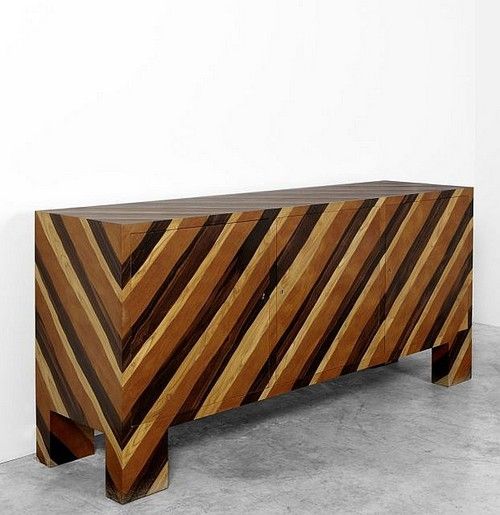
The desk being auctioned on June 13th is made of mahogany, brass and cane. It has a wonderful architectural and sculptural feel, full of straight lines and angles in contrast to the organic materials especially the cane of its construction. It almost doesn't look functional, it's futuristic, but more of an elegant decorative objet d'art, a piece of sculpture to inhabit your room. The desk, lot 187, has a pre-sale estimate of $20,000-30,000.

This week's second find is also by Jean Royere- a bibliotheque circa 1937, lot 184, with a pre-sale estimate of $25,000-35,000. The bookcase is made of zebrawood and sycamore with bronze detailing. It has glass doors in the center behind which are adjustable shelves. This piece is deceptively simple in its architectural form. The surface of the bookcase is enlivened by the striped patterning of the zebrawood against the transparency of the glass and the hard edge of the bronze border which surrounds the facade's wood panels.
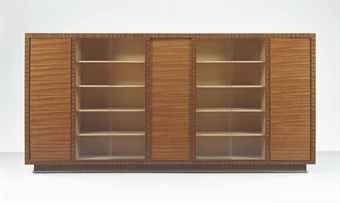
The next discovery for this week is a circa 1934 armchair by Pierre Patout (1879-1965), lot 334 with a pre-sale estimate of $6,000-8,000. Patout was an architect, urban planner and interior decorator. He worked in Rueil briefly before founding one of the first group practices in Paris with Levard in 1910. He contributed several projects to the Exposition internationale des arts decoratifs et industriels modernes, Paris, in 1925, including the Porte de la Concorde, and pavilions for the Manufacture Nationale de Sevres and for Jacques-Emile Ruhlmann's Hotel d'un Collectionneur. With their neo-classical vocabulary enhanced by Cubist-influenced sculptural reliefs, these buildings are typical of his Art Deco style; his prestigious town houses (for Ducharne, Paris, 1924 (destr.); for the Voisins, Boulogne-Billancourt, 1923 (destr.) and 1928; for the painter Alfred Lombard and his son, Boulogne-Billancourt, 1928) and blocks of flats (at the Porte de Champerret, 1928; and the Square Henri Path, 1928) are also characteristic. In 1926 he designed the first in a series of shops for the wine-merchants Nicolas.
The armchair was designed for use in the First Class Dining Room of the ocean liner Normandie. The piece is made of mahogany. Its legs end in brass sabots and it has its original woven tapestry upholstery. The chair has a wonderful Art Deco style and evokes the heydey of transatlantic ocean travel. It would be great to build a room around this chair as the centerpiece and perhaps one could eventually find a mate to make a lovely pair.
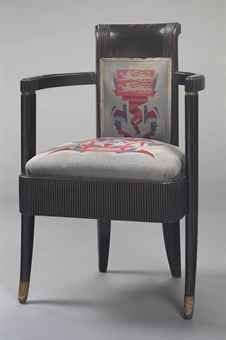
The fourth discovery this week is pair of walnut Art Nouveau armchairs by Louis Majorelle (1859-1926), lot 303 with a pre-sale estimate of $7,000-9,000. Majorelle was a French decorator and furniture designer who manufactured his own designs, in the French tradition of the ébéniste. He was one of the outstanding designers of furniture in the Art Nouveau style.
The armchairs have a wonderfully sinuous and organic feel particularly how the arms continue straight down into the legs of the chairs. The arms and legs are not smooth, but are covered with and enlivened by meandering tendrils. The crest rail has a lovely fan shape with a carved spray of flowers. And I think that Art Nouveau should be considered yet another revival expression of the Rococo with its curving forms and sinewy elegance.
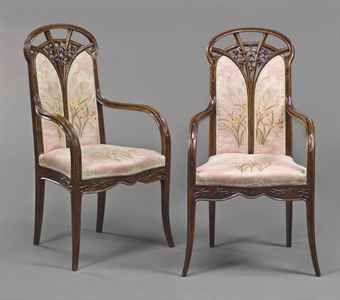
The fifth treasure this week is an unusual Art Nouveau lot and it would be interesting to see how the buyer eventually uses the piece. Lot 129 is a balcony railing circa 1903 by French architect Hector Guimard (1867-1942). The balcony railing is made of cast iron. This railing design was used on the exterior of many of Guimard's buildings in Paris including 17-19 rue la Fontaine, 43 rue Gros, Hôtel Mezzara and the Tremois Apartments, 11 rue François-Millet. The Art Nouveau style of the railing is expressed in its wonderfully curvy and sinous form. There is not a straight line anywhere.
How would one use this piece? Why not mount it on a wall in the drawing room making it the centerpiece and focal point of the room. It could be the starting point for a very creative space.
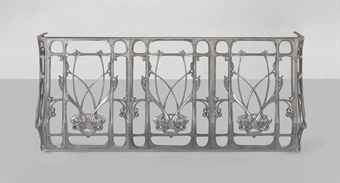
The last find for the week is not French but American, but also an expression of the Art Nouveau moment of the Majorelle armchairs and Guimard balcony railing. Lot 122 is a Tiffany Studios six light tulip chandelier, circa 1910, with a pre-sale estimate of $12,000-18,000. The piece is made of favrile glass and bronze. It is a delightfully warm organic piece and much more appealing to me than the multi-colored Tiffany table lamps whose original beauty I think has been damaged by all of the ersatz imitators. This chandelier would work well in a variety of settings from a sleek modern room to something more transitional or traditional.
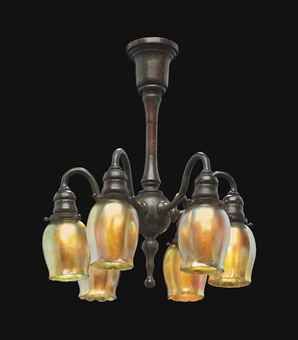
This week has been an interesting tour from 1950's modernism to Art Deco to Art Nouveau. My favorite find this week is the Pierre Patout armchair that was made for the Normandie ocean liner. For me it evokes the romance of transatlantic travel, when travel was an art, rather than a chore where one is packed in tight with few amenities or luxuries. It would be fab to use the Patout chair and the colors and feel of its upholstery as the starting point of a room and hopefully a mate would come along one day to complete the setting.
Until next week.
If you are looking for an antique or vintage treasure and would like my help, please contact me at [email protected]
Kelly T Keating
www.theantiqueflaneur.com
AUCTION FINDS OF THE WEEK- JUNE 3RD: 20TH CENTURY DESIGN
by Kelly Keating on 06/07/13
This week's auction finds offer 4 items beginning with a great piece of furniture and ending with a quirky jewelry box. All of the items were made in the 20th century at varying times and show the wide variety of design expressions in the modern era. If you are looking to furnish a room in a "modern" style here are some great objects for inspiration.
This week's first discovery is a wonderful Limbert Furniture Company, Grand Rapids, MI, circa 1908 3 drawer library table with copper hardware in the Arts & Crafts style- lot 171 at Rago Arts and Auction Center in Lambertville, NJ on June 8 with a pre-sale estimate of $2,500-3,500. The library table has the typical Arts & Crafts mortise and tenon construction which proudly displays how the piece was put together rather than hiding it. What a great piece for a library, dining room or center hall and let's fill the top with Arts & Crafts pottery and books for a great look or this week's other treasures.
Charles P. Limbert (1854-1923) was founder of the Limbert Furniture Company and a contemporary of Gustav Stickley, although the two most likely didn't know each other. (Stickley was more of a self-promoter while Limbert was content to let his furniture speak for itself). Limbert's quartersawn oak furniture is characteristic of the Arts and Crafts movement in America; some of it looks similar to that produced by other makers of the day. Many of the company's better pieces, however, are pleasingly unique, are solidly constructed and stand on their own merits. Compared with Stickley's work, Limbert's designs were typically less severe and more visually interesting, usually achieved through the use of cut-outs and other elements inspired by such diverse influences as English Arts and Crafts, Dutch folk furniture, Scottish architect/designer Charles Rennie Mackintosh, and the Vienna Secession.
The passage above is an apt description of the library table at Rago. There is something pleasing about and it does indeed lack the severity of a Stickley piece. Particularly nice is the curved inner profile of the legs which softens the design and makes it more sensuous.
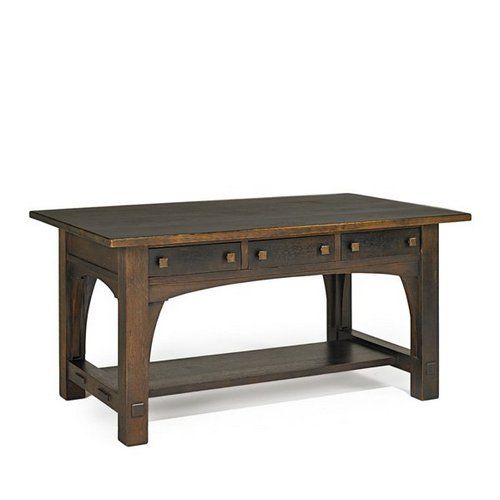
This week's next discovery is a green matte glazed Arts & Crafts vase by J B Owens Pottery- lot 136 at North American Auction Company in Bozman, MT on June 15th with a pre-sale estimate of $400-600. This piece would look great on the Limbert library table with a single lily or blossom branch. The vase features a very rare Teco Matte Green Drip Glaze and is circa 1900. The piece is a four footed gourd shaped vase with four unique applied handles that meet around the circumference of the narrow vase opening. What a great color and shape that combine to create a very tactile appealing object.
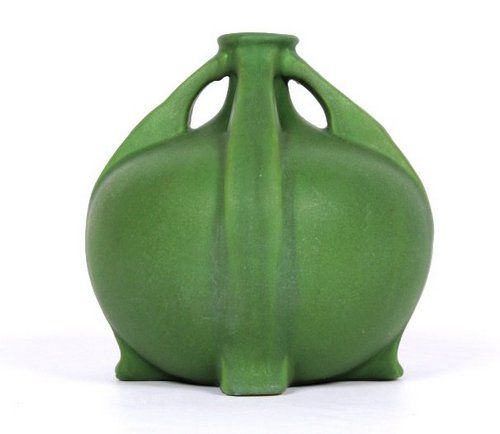
The third treasure this week is a large glazed Art Deco circa 1930's wall plaque by Waylande Gregory (1905-1971) featuring a stylized nude woman in a lush landscape- lot 302 at Rago Arts and Auction Center in Lambertville, NJ on June 8 with a pre-sale estimate of $2,000-3,000. Nicely framed this plaque would look quite well above the Limbert table. Gregory was one of the most innovative and prolific American Art Deco ceramics sculptors of the early twentieth century. His groundbreaking techniques enabled him to create monumental ceramic sculpture, such as the "Fountain of the Atoms" and "Light Dispelling Darkness", which had hitherto not been possible. He also developed revolutionary glazing and processing methods and was a seminal figure in the studio glass movement. Although this lot is a small work (17"x17.5") it certainly demonstrates Gregory's command of the medium.
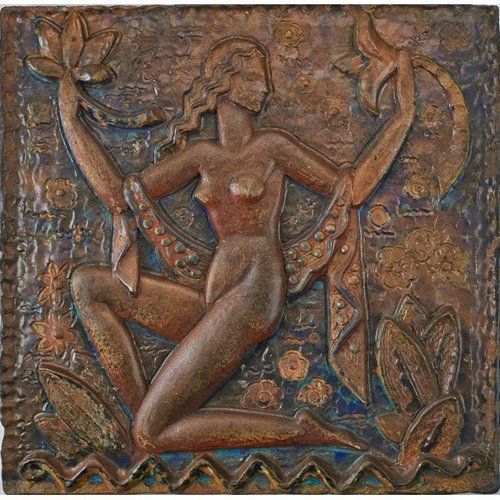
The last discovery this week is a Francis Thenet circa 1920 bronze octagonal jewelry box featuring a squirrel motif. This piece is a quirky little lot, but I love the patina, shape and how the squirrel fills the space of the octogonal lid. The squirrel jewelry box, lot 2413, is being auctioned at Michaan's Auction House in Alameda, CA with a pre-sale estimate of $900-1,200. I would like to see this box as part of a grouping on the Limbert library tablescape.
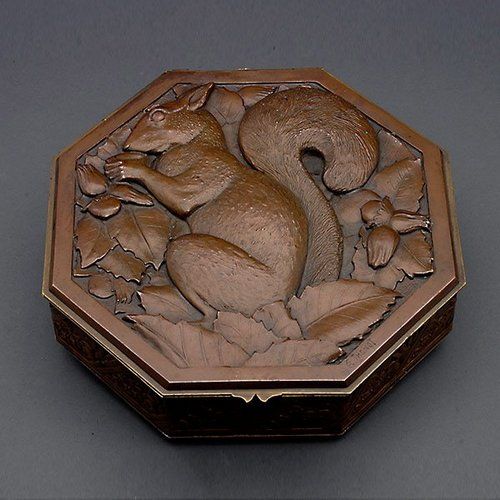
I hope one of this week's auction picks inspired you for the design of your own space. All of this week's objects work well together. The Limbert library table could be our centerpiece with the Owens pottery vase and Thenot jewelry box as part of its tablescape with the lovely and stylish Gregory plaque hanging above.
Contact me at [email protected] if I can find you a wonderul auction treasure.
Till next week.
Kelly T Keating
www.theantiqueflaneur.com
AUCTION FINDS OF THE WEEK- MAY 27TH: ACCESSORIES, ACCESSORIES, ACCESSORIES
by Kelly Keating on 05/27/13
This week's auction finds are all about accessories. Accessories are the jewelry of a room, the last finishing touch that completes a space and the pieces that truly express the identity of the room's inhabitant. I like room ornaments that stand in contrast to the design of the room in general. A decorative item that can draw the eye into the room, say a wonderful pair of large silver candlesticks on a mantel, and serve as a counterpoint to the room's style works best for me.
All of the items this week except one are being auctioned at Doyle's Belle Epoque: 19th & 20th Century Decorative Arts in New York on June 5th. One item is being auctioned on June 15th at Leland Little Auction & Estate Sales Ltd. in Hillsborough, NC.
This week's first discovery is a bit old fashioned. Lot 307 is a Japanese Export Silver Coffee and Tea Service from the Meiji Period (1868-1912). I am thinking it is earlier in the Meiji period rather than later. It was made for the Western market and is comprised of a kettle on stand, coffee pot, teapot, creamer, two-handled covered sugar bowl and a tea caddy, each with a gorgeous chased and repousse or applied iris decoration against a stippled ground.
At one time in domestic life it was de riguer to have a coffee and tea set on the sideboard. But in today's world, no one really stops for afternoon tea and no one wants to polish silver. A set like lot 307 in its naturalistic forms and impressive array of items would look wonderful on any dining room sideboard from varying periods, but one has to commit to not only polishing the set, but actually also using it despite its general obsolescene. Have a dinner party and wow your friends when you put a coffee and tea service like this on the table for dessert. They will enjoy and take pleasure in your effort.
The Japanese export service has a pre-sale estimate of $3,500-4,500. And no need to spend this much or get a sterling service. There are plenty of nicely appointed plate services available for around $500 that will do the trick.
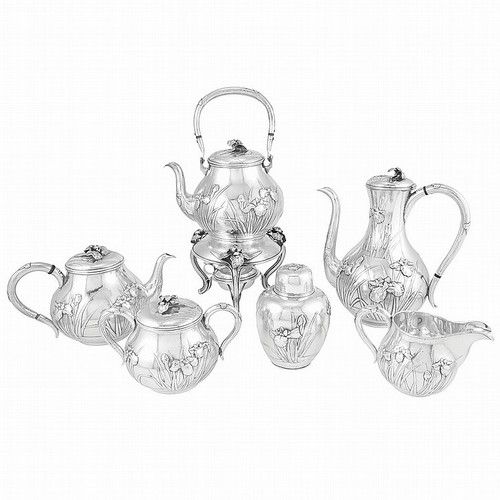
The second adornment this week is another silver object lot 240- a pair of Gorham Egyptian Revival sterling silver candlesticks in the form of cobras surmounted with a lotus blossom form candle holder. The pair date from 1875 to 1900 with the 1880's being the most likely date. The Egyptian Revival is usually dated from 1820-1850, but silver examples with Egyptian motifs appear long after that date into the 1880’s. And of course, there was another great Egyptian revival after 1922 when King Tut’s tomb was found by Harry Carter.
The cobra sticks I think could only exist in a vary daring interior. Perhaps a wonderful Art Deco inspired space with a touch of chinoiserie, an early 20th century Chinese Deco rug and a lacquer piece could contain the strength of the snake candlesticks. The sticks are wonderfully alive and naturalistic and the lotus blossoms on the heads of the snakes are simply gorgeous. The cobra sticks have a pre-sale estimate of $2,000-3,000.
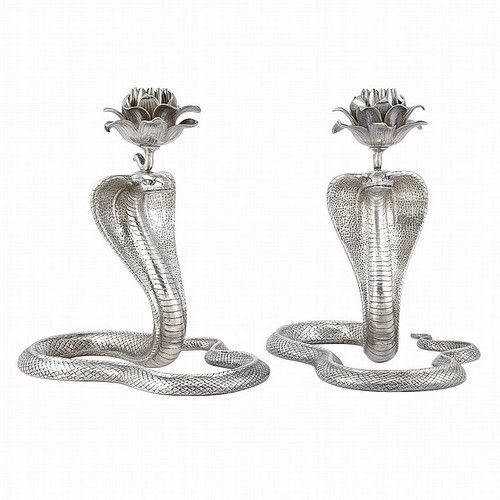
The third find of the week is our final piece of silver- lot 281 a Georg Jensen Silver Water Pitcher with a pre-sale estimate of $1,500-2,500. The pitcher was designed by Johan Rohde, circa 1925-36. It is of ovoid form, with a sloped mouth and elongated C-form handle and a subtle hand-hammered finish. Silver is not only old fashioned, but can also be found in wonderful modern shapes and designs like this Jensen pitcher which would look lovely on a Mid-century Modern sideboard. It could be used for iced tea, lemonade or just water. If you have a piece of silver you love, use it! Your guests will appreciate it. Just remember whether sterling or plate do not overpolish pieces. Use a mild silver polish about 2-3 times a year. In between store pieces in silver keeper bags or if displayed, use a mild soap (nothing with lemon in it) to clean your item.
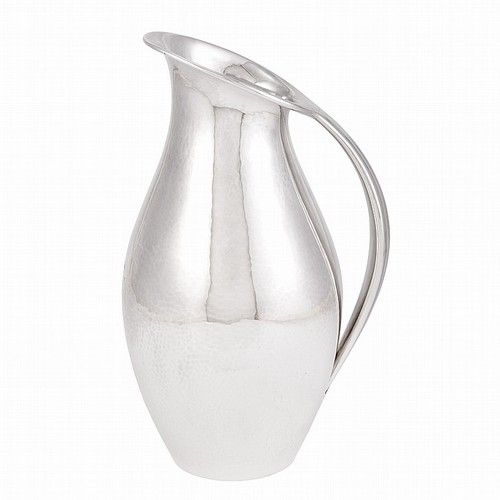
The fourth accessory discovery this week is lot 529 also at Doyle New York- Companion Pair of Galle Faience Figures of Cats with a pre-sale estimate of $2,000-3,000. This choice is wacky, no? I am definitely not a cat person, but have always found these Galle cats very appealing. Each cat is modeled in a seated pose with a yellow glaze and decorated with a blue and white striped tail and conforming hearts and spots on the body. They date to the late 19th or early 20th century. The yellow and blue color combination of the cats is happy and cheerful. They are a good size at 13" and would look wonderful on a white mantel in a crisp English country or French country inspired room in corresponding colors.
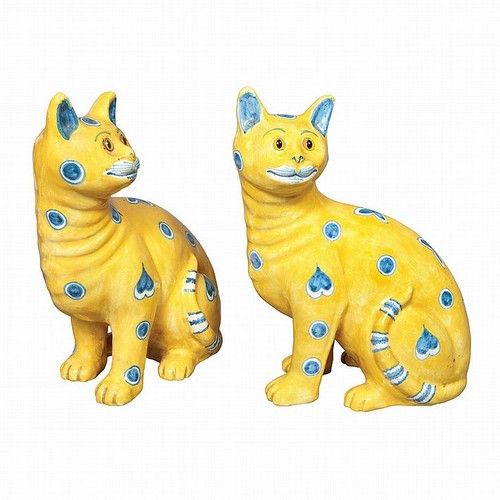
The next treasure for this week is lot 534 another piece of Galle- an Acid Etched Cameo Glass Vase circa 1900 with a pre-sale estimate of $8,000-10,000. With an impressive height of almost 25" this vase is a flattened ovoid form, with a flared mouth, in olive green, amber and colorless glass and decorated with a continuous landscape scene that includes trees and a moored rowboat in a placid lake. It has a frosted and glossy finish. This Galle vase is an impressive collector's lot. But how about creating a room with this piece as a starting point? Would we dare to even put flowers in it? Of course White, cream, pink, purple, green!
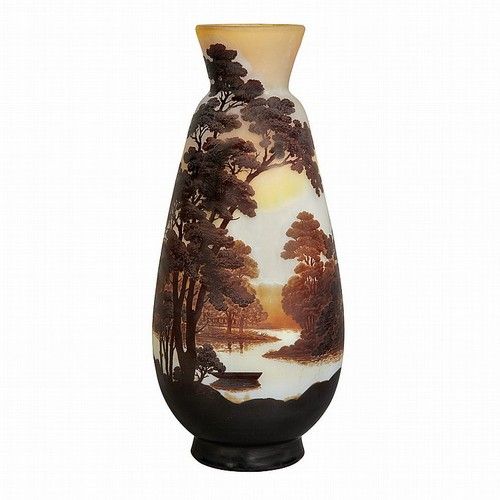
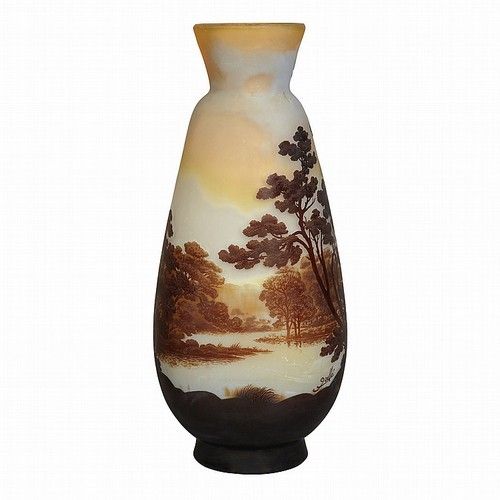
The final discovery this week is the only lot not being auctioned at Doyle New York. Lot 508, an Art Deco Magazine Rack, is being auctioned on June 15th at Leland Little Auction & Estate Sales Ltd. in Hillsborough, NC with a pre-sale estimate of $200-400. The silvered cast iron magazine rack is in the form of a hound jumping through a foliate ring. The piece is unmarked. This magazine rack has wonderful style and design. I would use it on a mantel or a sideboard as a piece of sculpture rather than as a magazine rack which always look chaotic and messy to me when full. Add a little style to your room with this decorative accessory!
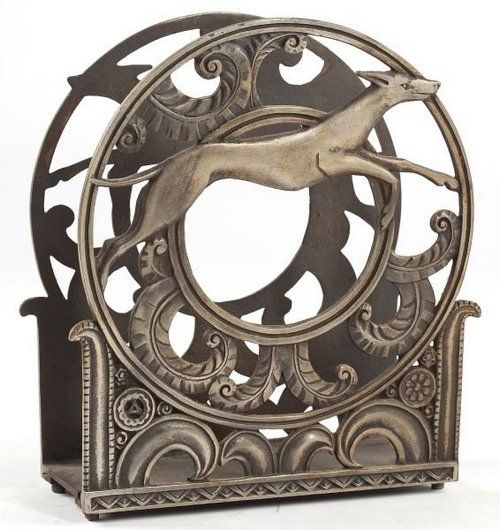
This week's auction finds were all about accessories from silver to silvered metal. After the paint, the rug, the furniture and the light fixtures a room (even a minimal one) needs further adornment with decorative accessories that dress the space and enhance the other elements in it. Ornaments bring a room to life and express the character of the person who inhabits it.
If you need any help finding decorative accessories for your room, contact me at [email protected]
Till next week,
Kelly T Keating
www.theantiqueflaneur.com
AUCTION FINDS OF THE WEEK- MAY 20TH: CHINOISERIE ON MY MIND
by Kelly Keating on 05/24/13
This week's finds are all grouped under the heading chinoiserie. Chinoiserie "a French term, signifying "Chinese-esque", refers to a recurring theme in European artistic styles since the seventeenth century, which reflect Chinese artistic influences. It is characterized by the use of fanciful imagery of an imaginary China, by asymmetry in format and whimsical contrasts of scale, and by the attempts to imitate Chinese porcelain and the use of lacquerlike materials and decoration." This decorative style is a wonderful and luxurious element that can be added to almost any room in varying degrees. It is a play between East and West and while an artistic style it often speaks to the worldview of the West and how it viewed and treated the Other. The 3 finds this week are all being auctioned at Christie's in New York on June 6.
The first discovery of the week is a Louis XV Ormolu-mounted Chinese Black, Gilt and Polychrome Lacquered Commode, lot 6, with a pre-sale estimate of $100,000-150,000. The chest is dated circa 1750 by Joseph Shmitz. It has a purple veined marble top above two drawers decorated with Chinese figures in pavillions, the angles with pierced mounts, standing on splayed legs and stamped twice J. SCHMITZ and JME on the top. The marble and the lacquer combine to make a rich sumptuous display. The scene on the drawers has all the hallmarks of chinoiserie style- asymmetrical design, contrast of scale and use of lacquer.
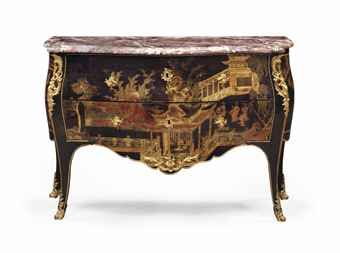
This week's second treasure is a pair of Louis XV Ormolu-mounted, Scarlet, Gilt and Polychrome Lacquered Encoignures or corner cabinets, lot 2, with a pre-sale estimate of $20,000-30,000. The pair were made circa 1750. Each chest has a breche d'alep marble top above a bowed door decorated with Chinese figures in pavilions and enclosing two shelves. This door is most likely Chinese in origin and surrounded by probably European decoration.The pair stand on splayed legs with rocaille sabots. The color of this pair of corner chests is superb and delicious and how wonderful to have pieces that fit into the corner of room.
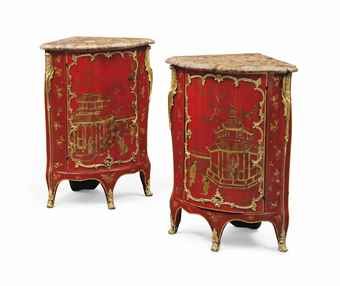
This week's final find is a wonderful George II Rococo Coffeepot with Chinoiserie Decoration, lot 35, with a pre-sale estimate of $5,000-8,000. The piece was made in 1759 by William Tuite in London. It is a baluster form with a shaped circular foot cast and chased with scrolls and foliage. The body is chased with two scenes of Chinese figures in landscapes in which one figure seems to be buying tea or rice from the other. These 2 figures are enclosed by elaborate rocaille, scrolls, foliage and fishscale, with shell and scroll spout and wood scroll handle. The hinged cover has conforming decoration and the body is engraved with a coat-of-arms. How handsome this piece would look on a sideboard of a similar date!
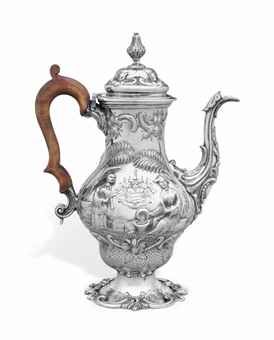
This week we took a small tour through the "Orient" as it was seen and understood by the 18th century Western mind. These objects are gorgeous but also are about transactions of power and how the West depicted and commodified the Other eventually exercising their dominion over that Other in the 19th century. Still I would have any of these objects in my own space, because their "politics" only enriches their artisitic achievement.
Contact me if you are looking for a piece of chinoiserie at [email protected].
Till next week...
Kelly T Keating
